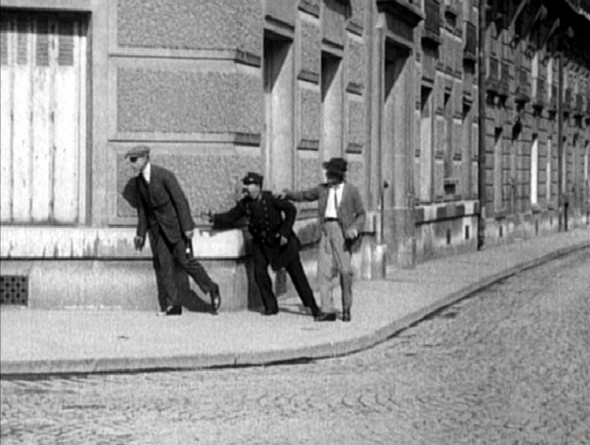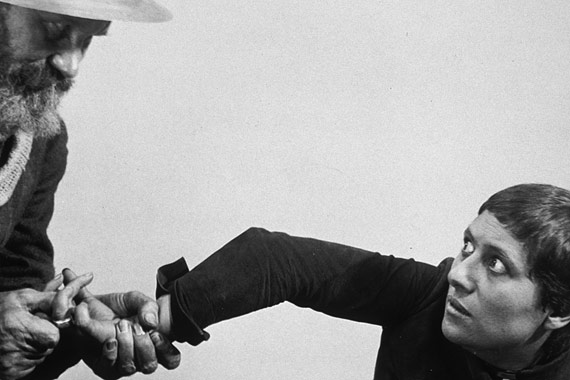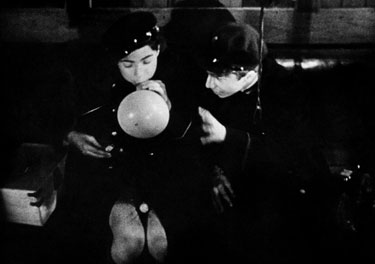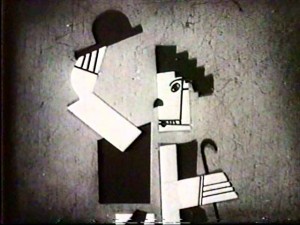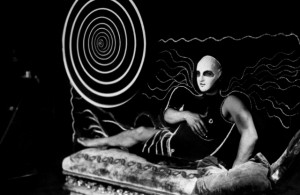From AFI Education Newsletter (January-February 1982). Because of the length of this, I’ll be running it in two installments. — J.R.
EXPERIMENTAL FILM:
FROM UN CHIEN ANDALOU TO CHANTAL AKERMAN (Part 1)
UNIT l: lntroduction
One distinct advantage to teaching a course in experimental film as opposed to avant-garde film is that it automatically gives one much more leeway in terms of screenings to be selected as well as overall teaching approaches. While “avant-garde cinema” can be regarded, by and large, as a distinct body of work with its own traditions, history and critical literature, “experimental film” is a rather more subjective and ambiguous category, and one that cuts across certain forms of commercial as well as avant-garde filmmaking. (There are many more references to various commercial forms of filmmaking, including Hollywood, in David Curtis’s Experimental Cinema, than there are in P. Adams Sitney’s Visionary Film: The American Avant-Garde.)
Consequently, any teacher setting out to plan a course in experimental rather than avant-garde cinema automatically has a greater amount of material to select from, and substantially more freedom in defining the scope and limits of his or her subject. By the same token, the demands placed on one’s imagination, creative input and organizational capacities might also be significantly greater.
Any course in experimental film will, of course, have to concern itself with the avant-garde in considerable detail. But, if at all possible, it should avoid collapsing the two categories into one ill-defined, all-purpose unit. It is important to attempt to distinguish at the outset between social and aesthetic definitions of the avant-garde, without of course projecting the impression that aesthetic definitions have no social implications, or conversely, that social categories have no aesthetic meanings and consequences. One should attempt to clarify that some avant-garde work can be tradition-bound as well as (or in some cases, instead of) experimental in nature.
One essential requirement of this task, it would seem, is that the teacher deal with the experimental and avant-garde categories critically and historically, in as precise a manner ds possible, from the very beginning. This entails some study of what Un Chien Andalou meant in relation to the French cinema as a whole and within the avant-garde during the late Twenties. It also involves making a distinction between what, say, the jump-cuts of Breathless and the match cuts of Last Year at Marienbad looked like in the early Sixties — how they were and/or weren’t “experimental” at the time — and how they register today, formally, conceptually and dramatically.
The social/aesthetic distinction mentioned above is only one of the central polarities that should be considered. Partly because experimental and avant-garde work is defined in terms of its oppositions, and partly due to the indelible mark of Hegelian and Marxist dialectics on much European thought about the avant-garde, teachers will naturally be drawn to defining their terrain with the help of a good many useful polar categories or antimonies. Some of these would naturally include American versus European, abstract versus figurative, narrative versus nonnarrative, animation versus live-action, silence versus sound, and so on.
At the same time, the teacher should guard against the temptation to overvalue the “useful” if this threatens to remove too many of the teeth in any sort of oppositional cinema by making it overly safe, remote, conformist and academic. For this reason, certain antinomies used by an essay such as Peter Wollen’s “Counter Cinema: Vent d’Est” – identification versus estrangement, transparency versus foregrounding, closure versus openness and fiction versus reality, among others — are undoubtedly helpful as descriptive tools, but should probably be regarded with some skepticism when it comes to defining either terms or reception or a social praxis in terms of an American classroom situation. Precisely because this film by Jean-Luc Godard lends itself so readily to being a “textbook” illustration of counter-cinema in Wollen’s terms, its likelihood of challenging or broadening a student’s conception of aesthetic and social issues may well be reduced as a consequence — at least in relation to less systematic but more multi-faceted and vigorous works like 2 or 3 Things I Know About Her or Numéro Deux, which deal with much wider ranges of experience.
This hits upon a crucial issue which should be borne in mind throughout any planning of an experimental film course. If, on one level, the task of an experimental film is initially to confuse spectators — while the task of an experimental film teacher is initially to clear up confusion — the teacher should be careful to avoid reducing his or her work to simple, dramatic and symmetrical problem-solving. The “clearing up” of issues, if pursued too doggedly for its own sake, and without sufficient appeal to wider contexts, might run the risk of lessening the impact of the films for the sake of a teachable clarity.
It can be very rewarding, for instance, to try out all sorts of analytical and interpretive systems on Un Chien Andalou; each can deepen one’s overall sense of the film. But it might be rather dangerous to trust any single one of them too much, and privilege it as a skeleton key that unlocks all mysteries. One would be wise to hold in mind Luis Buñuel’s radical claim that Un Chien Andalou, far from being an object that sought after either beauty or poetry, was ultimately “nothing more nor less than a desperate call to murder.”
General Reading:
Bordwell, David and Kristin Thompson, Film Art: An Introduction, Reading, MA: Addison-Wesley Publishing Company, 1979.
Burch, Noël, Theory of Film Practice, Princeton, NJ: Princeton University Press, 1981.
Curtis, David, Experimental Cinema, New York: Delta Books, 1971 .
Durgnat, Raymond, David Ehrenstein and Jonathan Rosenbaum, “Obscure Objects of
Desire: A Jam Session on Non-Narrative,” Film Comment, July-August 1978, pp. 60-64.
Dwoskin, Steve, Film Is: The lnternational Free Cinema, Woodstock, New York: The Overlook Press, 1975.
Eisenstein, Sergei, Film Form and The Film Sense, New York: Meridian Books, 1967.
Farber, Manny, Movies, Hillstone, New York: Hillstone, 1971 .
Gidal, Peter, ed., Sfructural Film Anthology, New York: British Film lnstitute/New York Zoetrope, 1978.
Le Grice, Malcolm, Abstract Film and Beyond, Cambridge, Massachusetts: The MIT Press, 1977.
Mekas, Jonas, Movie Journal, New York: Collier Books, 1972.
Michelson, Annette, Camera Lucida/Camera Obscura, Cambridge, Massachusetts: The MIT Press, 1982 (in press). [2012 note: In fact, this has never been published.]
Sitney, P. Adams, ed., The Avant-Garde Film: A Reader of Theory and Criticism, New York: New York University Press, 1978.
Sitney, P. Adams, ed., Film Culture Reader, New York: Praeger, 1970.
Sitney, P. Adams, Visionary Film: The American Avant-Garde 1943-1978 (second
edition), New York: Oxford University Press,1979.
UNIT II: France in the Twenties
One good reason for beginning a study of experimental film with France in the 20s is that few places and times in the history of any art can be considered more international in scope. Thus France in the 20s means not only such French filmmakers as René Clair, Jean Cocteau, Germaine Dulac, Fernand Léger, Jean
Renoir and Jean Vigo — many of whom went on to become international figures — but also the Spaniard Luis Buñuel and the Dane Carl Dreyer, among many others choosing to work in France. (Roger Shattuck’s The Banquet Years provides an excellent background regarding avant-garde activity in the other arts during the early part of the century,) It was only in France, too, that a figure like the Vicomte de Noailles could finance such costly revolutionary films as Cocteau’s Blood of a Poet and Buñuel’s L’Age d’Or (The Golden Age), and where Carl Dreyer could be given the extensive means and freedom to make his film about Joan of Arc.
Screenlngs:
Paris qui dort (The Crazy Ray) (1923, 60 min.) Directed by René Clair — A fantasy about Paris immobilized at precisely 3:25 in the afternoon, Clair’s first feature is a film which is almost explicitly about film, in which time can stop and start up again at the whim of an amiable mad scientist. It has many links with Dada as well as Surrealism, and might profitably be shown with the subsequent Clair short, Entr’acte (1924), based on a screenplay by Francis Picabia. Exploiting and calling attention to the properties of the medium in a number of ways — speeding time up, slowing it down, freezing it, reversing it, and exploring the Second Empire monuments of Paris (along with the International Exhibitions celebrating the progress of technology) with some of the dryness of a documentary, The Crazy Ray can be used as an excellent example of the popular experimental film, and one that can be used to illustrate the links between avant-garde traditions, comedy and science-fiction.
Ballet Mécanique (1924, 20 min.) Directed by Fernand Léger, who was assisted by Dudley Murphy and Man Ray, this short was reportedly influenced by Abel Gance’s La Roue. Léger wrote, “The idea tor the film came to me in order to be certain of the plastic possibilities of these new elements expressed in movement. The repetitions of shapes, of slow or rapid rhythms, allowed extremely rich possibilities. An object could become, all on its own, a tragic, comic or spectacular sight. It was an adventure in the land of wonders.” A useful pairing for purposes of contrast might be made with Dudley Murphy’s own 1929 American short with Duke Ellington, Black and Tan, which utilizes certain ideas and techniques also found in Entr’acte and Ballet Mécanique.
La Passion de Jeanne d’Arc (The Passion of Joan of Arc (1927, silent speed 123 min., sound speed 82 min.) Directed by Carl-Theodor Dreyer — A pivotal film in many respects, Dreyer’s last silent feature can be linked to many different facets of experimental film tradition: the idiosyncratic handling of space (treated by both Noël Burch and David Bordwell, the latter in considerable detail), the experimental adoption and application of mainstream techniques derived from Griffith (notably the close-up and crosscutting), the use of German Expressionist sets (designed by Hermann Warm), ” the rhythmic editing and typage (both influenced in part by Soviet cinema), and, indeed, Impressionistic montage and subjective camerawork from the French avant-garde during the Twenties. From this point of view the film might be regarded as both a culmination and a synthesis.
Le Sang d’un Poète (Blood of a Poet) (1930, 58 min.) Directed by Jean Cocteau — Split into four episodes, Cocteau’s first film, linked by his own commentary, is said to take place between the explosion of a chimney in the first sequence and its fall to the ground in the last. Described by Cocteau as a poem on celluloid and one that should be taken as a response to Surrealism rather than as a Surrealistic statement, it continues to be a highly influential film within the experimental tradition for its explorations into the possibilities of a highly personal and self-referential form of filmmaking.
Zéro de Conduite (Zero for Conduct) (1933, 45 min.) Directed by Jean Vigo –Banned by French censors until the mid-Forties, this exuberant, anarchist ode to rebellion at a repressive boys’ school can be profitably compared to (and contrasted with) several New Wave films, on political as well as aesthetic grounds. (The same could be said of Cocteau’s work, although here his Orphée would probably serve better than his Blood of a Poet in spelling out the ancestry of; say, Godard or even Demy.) The separate forms of stylization at work in the depiction of the children and the adults in this film might serve as one fruitful point of departure, as would a consideration of Maurice Jaubert’s score and its functions.
Readings:
Abel, Richard, “The Contribution of the French Literary Avant-Garde to Film Theory and Criticism (1907-1924),” Cinema Journal, Vol. XlV, No. 3, Spring 1975, pp. 19-40.
Bordwell, David, ” La Passion de Jeanne d’Arc,” The Films of Carl-Theodor Dreyer, Berkeley: University of California Press, 1981 , pp. 66-92.
Cocteau, Jean, Cocteau on the Film, New York: Dover, 1972.
Drummond, Phillip, “Textual Space in Un Chien Andalou,” Screen, Autumn 1977, Vol. 18, No. 3, pp. 55-119.
Michelson, Annette, “Dr. Crase and Mr. Clair,” October No. 11, Winter 1979, pp. 31-53.
Renoir, Jean, My Life and My Films, New York: Atheneum, 1974.
Salles Gomes, P.E., Jean Vigo, Berkeley: University of California Press, 1971.
Shattuck, Roger, The Banquet Years, New York: Harcourt Brace, 1968.
Williams, Linda, “The Prologue to Un Chien Andalou: A Surrealist Film Metaphor,”
Screen, Winter 197617, Vol. 17, No. 4, pp. 24-33.



